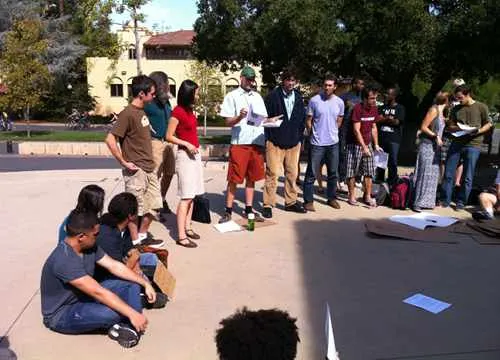Table of Contents
The general walkout Occupy Stanford held last Wednesday in White Plaza revealed that the common political noise and their namesake distrust of Wall Street institutions may be the only universal principles that members share.
The walkout, organized as a way for professors and students to show solidarity with ongoing Oakland protests as well as voice their concerns with the economic and political situation, attracted a range of participants.
Their motivations were numerous. One undergraduate said he was “just here to fight the power.” Classics professor Rush Rehm was “angry at institutional guises of inequality,” while a PhD student expressed a “visceral hatred of the system” and another undergraduate was just “glad to see some activism.”
Despite differing stances, most resonated with the view of a broken political and economic system – which the above-mentioned PhD student articulated as “an economic form of capitalism not based on freedom…but profit.” He continued, “Wall Street is a casino where the stakes are human lives.”
Though they see this diversity of opinion as a strength, it has also been a source of criticism. Many critics have charged the movement with aimlessly broadcasting anger instead of creating real change.
“I can’t honestly perceive what [their] goals are,” said Eliana Arredondo, vice president of the Stanford Conservative Society. But she was quick to qualify her views by acknowledging her limited exposure to the campus movement.
Members of the Occupy Stanford group, such as Jay Cabrera, a long time activist and lifelong Stanford community member, point to the official statement of grievances from Occupy Wall Street as guidelines for their movement. But he also stated, “I don’t think the movement is ready [for specific goals] yet until it comes together and coalesces.”
Namir Shah, campaign director for the Stanford Democrats, stated, “In my opinion, the most important thing is for the movement to translate its frustration into feasible and sensible policy positions.”
Cabrera, however, has a different vision. “The movement will move opposite of coalesced organization,” he said. Cabrera, who has lately been working on the international level of the Occupy movement, instead promotes “a global consensus system” based on the local general assemblies that currently constitute the decision-making heads of the movement.
“For the most part, they are anti-leader,” explained Doug McAdam, professor of urban studies. But he does not consider this a weakness. “I don’t know of a successful [social] movement that hasn’t used a broad range of tactics” he said. “Other [established] groups who are broadly sympathetic must mobilize.”
The group, as with the larger Occupy movement, also faces criticism for perceived expression without action. Arredondo noted, “Anger alone won’t do anything.”
Those present at the walkout, however, rejected these criticisms.
“Blame Wall Street, blame the banks for misery,” stated Professor Hilton Obenzinger, “celebrate yourself because you can change the world.”
McAdam elaborated on the potential significance that Stanford could have on the Occupy movement in general. “Stanford would make a huge statement. That’s the kind of broadening of the movement that would inject energy into it,” he stated.
But other students call the presence of the Occupy movement at Stanford, “hypocrisy.”
“I hope they recognize [their status as part of the 1%]” remarked one undergraduate bystander.
Professor McAdam rejected that idea though, disagreeing on two points. “I don’t think that most students are part of the 1%…or can assume they’ll be part of it,” he said, citing an unstable economy. “The idea that it’s hypocritical is baseless…if I were part of the 1% this isn’t a society in which I would want to live.”
The issue still struck a chord with one student at the walkout who said, “I’m uncomfortable with hypocrisy…having grown up in an upper middle class liberal family.”
There is still uncertainty about the fate of the Occupy Stanford movement. McAdam said, “I’m not sure it will last long enough to merit the title of ‘movement.’”
Arredondo, though supportive of the aspect of activism at Stanford, admitted, “I haven’t seen the kind of movement that will bring about change [on campus].” Shah, however, stated, “I think the Occupy movement can play a role in fundamentally changing the political atmosphere in this country.”





